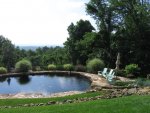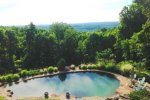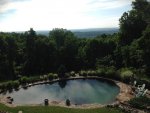OK, this is my first post which basically references my readings about pool chemistry and the perennial liquid chlorine, CYA, puck issues. My pool is likely unique so I'm hoping to get some advice and guidance that is specifically relevant. Basic facts:
Our pool is spring fed
I think it's about 23,000 gal
It has a constant leak so is constantly being refilled at some level, unknown. I have a leveler with the hose tied to the spring.
It is a naturally shaped, dug pool laid with some sand and carpets under and then covered with pool EPDM which is black. I dont care about staining.
The spring water is very clean and well balanced to begin with.
There are stone steps into the pool and stone apron. We have some frogs occasionally and have had a snake.....I digress..
It has a Hayward filter and Jayco 1.5 pump using DE
It has a recirculating pump which has an intake at the shallow end and takes water to a waterfall at the other end.
It is therefore possible to have excellent circulation as long as the water level is high enough (usually ok)
What I need is a plan to keep the pool in shape when we are not at home but have guests staying here.
Right now I am shocking to get rid of the last bit of algae from heavy rains and not sufficient attention.
I am using cal hypo
I used liquid chlorine but it was too cumbersome to apply and took up too much room to keep,and wasn't strong enough. Plus the stores are often out of the concentrated.
I would like to use cal hypo daily and have the pool vacuumed, DE etc once a week by a pool guy who may or may not know anything about TFP approaches.
I'd like to try a floater with pucks since everyone says if I put them in the skimmer and dont run the pump 24/7 it will damage the pump.
Lately I have been running the filter and the recirculation pump 24/7 but I have a timer and was running it only in the day time about 7 AM-7PM which is the schedule I prefer. What is the trade off between electricity use and chemicals?
Can someone provide a list of how best to treat the pool with these parameters? It needs to be EASY, something I could ask a guest to do without imposing on a daily basis and then instruct the pool guy for weekly service. For example I dont think I can ask a guest to go out and check the water chemistry every day. Maybe they could swirl a tester tab in the water and brush the sides a couple time during the week.. I did order the test kit recommended here. It just came today.
Basically I need minimal to do list based on assumption that only a few people will use the pool and only occasionally. No kids etc.
Suggestions welcome!
Our pool is spring fed
I think it's about 23,000 gal
It has a constant leak so is constantly being refilled at some level, unknown. I have a leveler with the hose tied to the spring.
It is a naturally shaped, dug pool laid with some sand and carpets under and then covered with pool EPDM which is black. I dont care about staining.
The spring water is very clean and well balanced to begin with.
There are stone steps into the pool and stone apron. We have some frogs occasionally and have had a snake.....I digress..
It has a Hayward filter and Jayco 1.5 pump using DE
It has a recirculating pump which has an intake at the shallow end and takes water to a waterfall at the other end.
It is therefore possible to have excellent circulation as long as the water level is high enough (usually ok)
What I need is a plan to keep the pool in shape when we are not at home but have guests staying here.
Right now I am shocking to get rid of the last bit of algae from heavy rains and not sufficient attention.
I am using cal hypo
I used liquid chlorine but it was too cumbersome to apply and took up too much room to keep,and wasn't strong enough. Plus the stores are often out of the concentrated.
I would like to use cal hypo daily and have the pool vacuumed, DE etc once a week by a pool guy who may or may not know anything about TFP approaches.
I'd like to try a floater with pucks since everyone says if I put them in the skimmer and dont run the pump 24/7 it will damage the pump.
Lately I have been running the filter and the recirculation pump 24/7 but I have a timer and was running it only in the day time about 7 AM-7PM which is the schedule I prefer. What is the trade off between electricity use and chemicals?
Can someone provide a list of how best to treat the pool with these parameters? It needs to be EASY, something I could ask a guest to do without imposing on a daily basis and then instruct the pool guy for weekly service. For example I dont think I can ask a guest to go out and check the water chemistry every day. Maybe they could swirl a tester tab in the water and brush the sides a couple time during the week.. I did order the test kit recommended here. It just came today.
Basically I need minimal to do list based on assumption that only a few people will use the pool and only occasionally. No kids etc.
Suggestions welcome!
Last edited:




